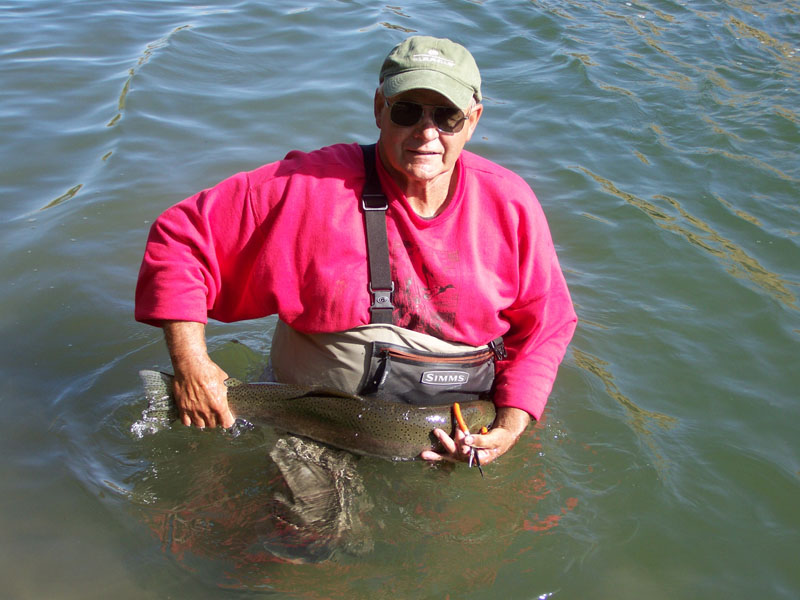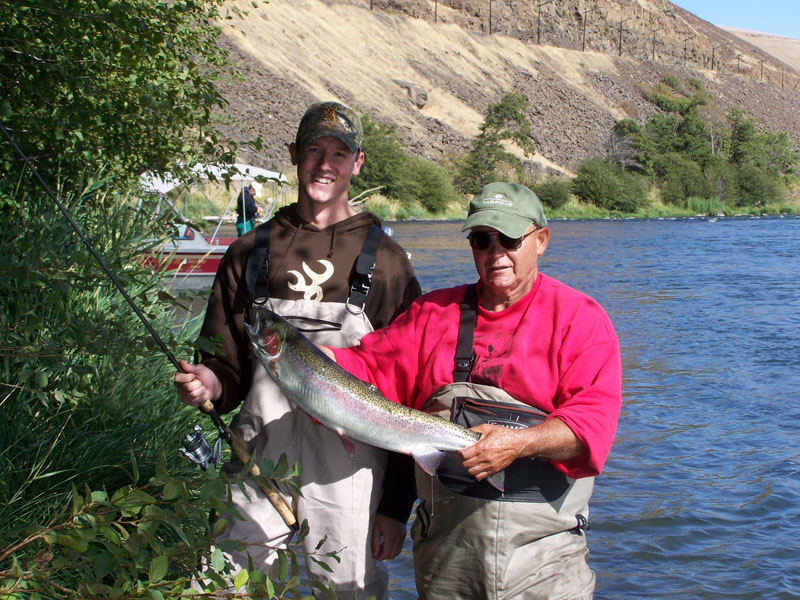Search
Latest Articles
Lower Deshutes Steelhead
by The Troutist, September 08, 2012
It seemed that once someone found out I had just worked the water they began picking my brain for all the info they could get. Don Hamblin graciously agreed to share 45 years of guiding experience and knowledge to pass on to all of my readers. Don has just retired from guiding the Lower Deschutes, the reason I just name this river is I just can’t believe that he will stop all together. Don started guiding at the age of 19 and basically spent his entire childhood angling with his father a disabled WWI vet which helped him in attaining the legendary status as a guide.
Last year when I was out with Don he mentioned that water temperature had really been affecting the success of the steelhead fishery. He was telling me that the dam was releasing warm water into the river; to be honest I wasn’t quite sure what he was talking about. I couldn’t understand how a dam could just release warm water that is until I did a little research on what he was talking about. A few years back the Round Butte Dam facility was required by Federal Mandate to install a Selective Water Withdrawal Facility. The first couple of years it was computerized mixing of the warmer top water and the deeper coldwater, although it met federal standards it was disastrous for steelheading.
Now the managers have a little more lead way on the mixture and claim this should do the trick. Only time will tell on this prediction.
For those of you that didn’t realize it water temperature has everything to do with the success or failure of angling for these majestic fish. Later in this article you will see what I am talking about. There are three strains of steelhead that hit this water during the late summer and early fall fishery. The natives which run on average between 4-6lbs, the Skamania Hatchery strain average between 7-10lbs, and the B-Run Idaho bound iron-heads average 12lbs and up. Combine all three runs and you have some very exciting opportunities.
Don’s largest to date has been a 44-1/2-inch long, 26lb bruiser. He chased it for three miles down-river and when he landed it he released it. He told me anything that fought that well and was that size deserved to be on his way. Back in the 80’s and 90’s a party of five anglers could expect at least 20 hook-ups, now 10 is considered a fantastic day. Back then the average size of an iron-head was also larger.
Last year on my adventure with Don I was amazed that he was actually calling the shots of when and where you were going to hook-up. I watched him take a reading on the temperature and he announced that it was 61 degrees and I should target a certain piece of water. Six casts later I had a hook-up with a 6lb native and when he turned his body into the current the fight was on, what a great time! We got a picture and sent him on his way.
Don broke down the water temperatures for me and what to expect. 61-degrees is the ideal temperature and you can expect the best angling of the day, up to 66-degrees expect fair angling, 68-degrees and up fly anglers can put your fly rods away because they will not rise to take something off of the top. For those of you throwing spoons, spinners, and lures you have a better chance in warmer waters because you are working closer to the bottom and have a better chance of putting your offering right in front of them.
With all of that said, Don pointed out the biggest mistakes he see’s time and time again. Start at the top of the run and work your way down. Covering the water thoroughly is a must. Many anglers when they first hit the water want to cast as far out as they can. First cast should be no longer than eight to ten feet out, second cast add two feet, repeat this until you have reached your max casting distance. Move a couple of feet down river then repeat you’re casting steps. This not only increases your chances for success but guarantees that you are covering all of the water and not just a small portion. “Many times I have had hook-ups with just six to eight feet of line out” says Hamblin. So when working the water keep that in mind.
For you fly anglers, Don prefers a 7wt. fly rod with a tapered fly line and for leader he uses 6lb test Maxima Chameleon. His most successful color of fly has been purple and he added that he likes it to hit the water as hard as possible. For your spinning reels Don prefers the #30lb Tuff Line with the swivel attached directly to his mainline and he doesn’t use leader. The fish are definitely not leader shy here. For you hardware chucker’s his favorite spinners are #4 and #5 Blue Fox spinners in silver/chartreuse, gold/purple, and gold/black. For spoons green is his first choice but he also uses an orange and gold combination. In faster water the Wiggle-Wart is a great choice, 99% of all steelhead are caught on the Fire Tiger color combination. He makes a few modifications by adding a Tad Polly hook on front and a #1 Si-Wash hook in the back. This should give all of you that make this trek a great place to start and help in making a great trip into a fantastic trip.
I wanted to thank Don for sharing all this information with us and wish him a happy semi-retirement. I just know that he is sitting on the water somewhere with Suzy his wife of 33 years fishing for pleasure and not business. So until next time may your next trout be your trophy mount.
Join me on my facebook page Uncle Wes. So until next time may your next trout be your trophy mount. The Troutist-“Uncle Wes” Malmberg.


